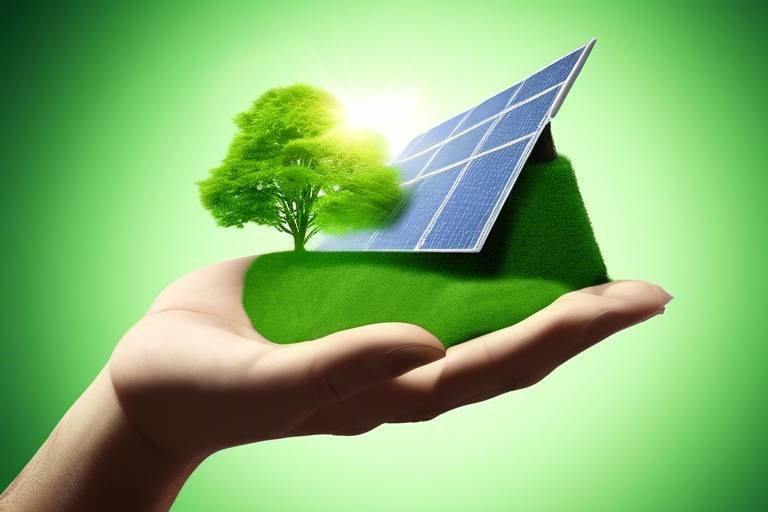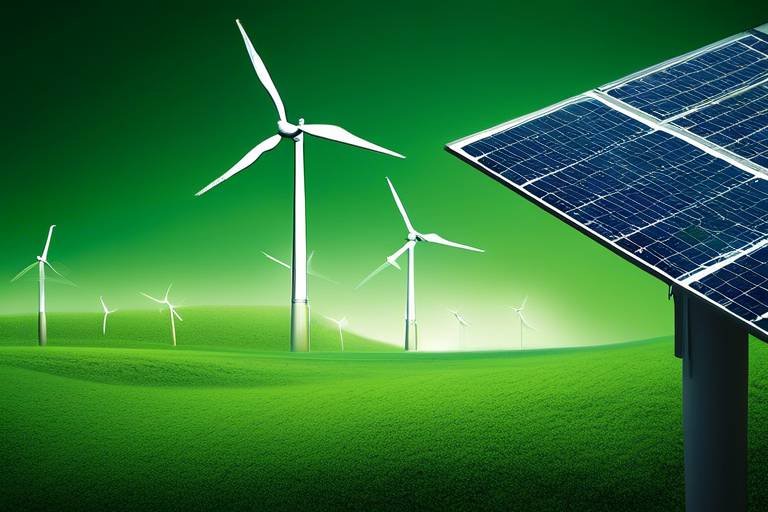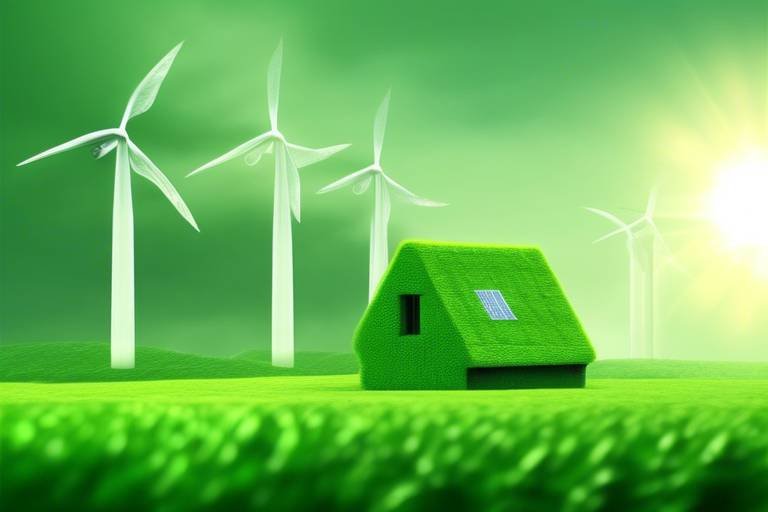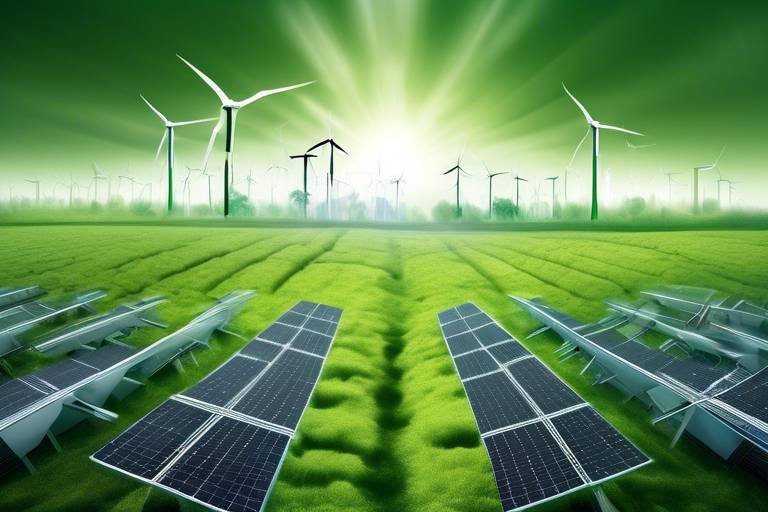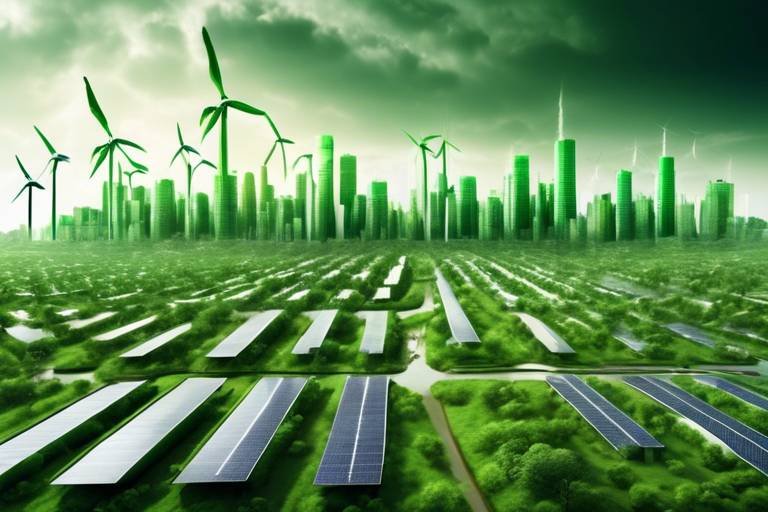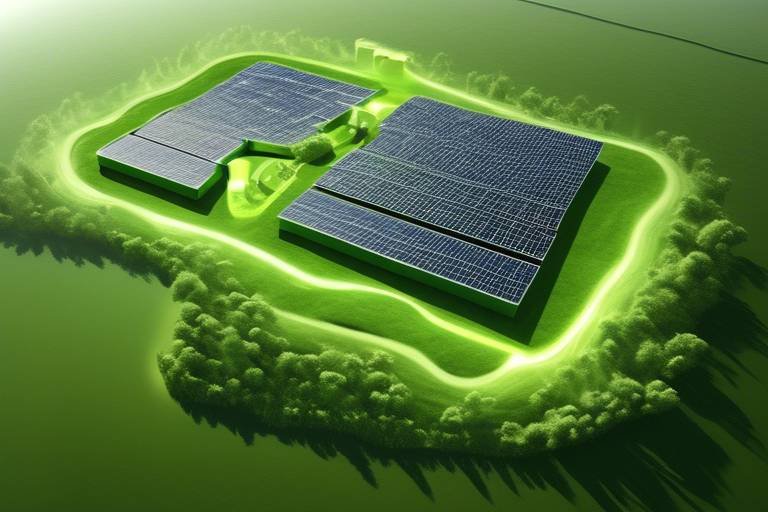How Green Energy Solutions Can Benefit You
Imagine a world where your energy comes from the sun, wind, or water—clean, sustainable, and abundant. This is not just a dream; it’s becoming a reality thanks to green energy solutions. In this article, we will dive into the myriad advantages of adopting these renewable energy sources, from their positive impact on the environment to the financial savings they can offer. You might be wondering, "How can switching to green energy really benefit me?" Well, let’s explore this exciting journey together!
Green energy refers to energy that is generated from natural sources that are replenished constantly. Think of it as the Earth's way of providing us with power without the nasty side effects. The most common types of green energy include:
- Solar Energy: Harnessing sunlight using solar panels to produce electricity.
- Wind Energy: Using wind turbines to convert wind into electricity.
- Hydroelectric Power: Generating electricity by using the flow of water in rivers and dams.
Each of these energy sources comes with its own set of benefits, making them not only practical but also essential for a sustainable future. Imagine your home powered by the sun—how cool is that?
One of the most compelling reasons to switch to green energy is its remarkable environmental impact. Traditional energy sources, like coal and oil, are notorious for their carbon emissions, which contribute to climate change and air pollution. By transitioning to renewable energy sources, we can significantly reduce these harmful emissions. Consider this: if every household switched to solar energy, the reduction in carbon footprint would be equivalent to taking millions of cars off the road!
Moreover, green energy helps in conserving natural resources. For instance, wind and solar power require no water for energy generation, unlike fossil fuels, which can deplete our precious water supplies. The shift to renewable energy not only leads to a healthier planet but also promotes biodiversity and protects ecosystems.
Now, let’s talk about the financial benefits of going green. You might think that installing solar panels or wind turbines is expensive, but the truth is, the long-term savings can be substantial. Here’s how:
- Lower Utility Bills: Once your renewable energy system is up and running, you’ll notice a significant drop in your monthly energy bills.
- Government Incentives: Many governments offer tax credits, rebates, and grants for adopting green technologies, making the initial investment more manageable.
In fact, studies have shown that homeowners who invest in solar energy can save thousands of dollars over the lifespan of their systems. It’s like putting money back in your pocket while saving the Earth—what’s not to love?
Another fantastic advantage of green energy solutions is that they promote energy independence. By reducing our reliance on fossil fuels, we can empower individuals and communities to generate their own energy. This not only enhances personal autonomy but also contributes to national security. When we rely less on imported oil, we reduce our vulnerability to geopolitical tensions and fluctuating market prices.
Picture a neighborhood where each home has its own solar panels, producing energy for its residents. This community not only thrives on its own energy but also supports each other in times of need. It’s a win-win situation!
The green energy sector is not just about saving the planet; it’s also about creating jobs. As the demand for renewable energy sources continues to rise, so does the need for skilled workers. From engineers to installation technicians, the green energy industry is rapidly growing and offers numerous job opportunities.
According to recent statistics, jobs in renewable energy are growing at a rate much faster than those in fossil fuels. This shift not only boosts the economy but also provides a pathway for individuals to enter a sustainable job market. Investing in green energy is investing in our future workforce!
Thanks to continuous technological advancements, green energy solutions are becoming more efficient and accessible. Innovations in solar panel design, wind turbine technology, and energy storage systems are making it easier for individuals and businesses to adopt renewable energy. For example, the latest solar panels are now more efficient than ever, converting a higher percentage of sunlight into electricity.
These advancements not only enhance the performance of renewable energy systems but also reduce costs, making green energy a viable option for more people. It’s exciting to think about how technology is paving the way for a sustainable future!
Adopting green energy solutions brings numerous benefits to local communities. Renewable energy projects can foster community engagement, improve public health by reducing air pollution, and enhance local economies through job creation and energy savings. Imagine a community that rallies together to invest in solar farms or wind energy projects, creating a sense of unity and purpose.
Moreover, these projects can lead to increased property values and attract new businesses looking for sustainable practices. The ripple effect of green energy can transform communities into thriving, sustainable ecosystems.
Despite the overwhelming benefits, there are challenges to implementing green energy solutions. Initial costs and infrastructure needs can be significant hurdles. However, there are potential solutions to overcome these challenges:
- Financing Options: Many financial institutions offer loans and payment plans specifically for renewable energy projects.
- Community Initiatives: Local governments can provide support through grants and incentives, making it easier for residents to adopt green solutions.
By addressing these challenges head-on, we can pave the way for a greener future.
The future of green energy looks incredibly promising, with ongoing developments and increasing adoption worldwide. As technology continues to advance and public awareness grows, we can expect to see more innovative solutions that make renewable energy even more accessible.
In conclusion, embracing green energy solutions is not just a trend; it’s a necessary step toward a sustainable future. By making the switch, you can enjoy the benefits of lower costs, environmental protection, and energy independence. So why wait? Join the green revolution today!
Q: What is green energy?
A: Green energy is energy derived from natural sources that are replenished constantly, such as solar, wind, and hydroelectric power.
Q: How does green energy impact the environment?
A: Green energy significantly reduces carbon emissions and pollution, helping combat climate change and promote a healthier planet.
Q: Are there financial benefits to switching to green energy?
A: Yes! Switching to renewable energy can lead to lower utility bills, government incentives, and long-term savings.
Q: Can green energy create jobs?
A: Absolutely! The green energy sector is rapidly growing and creating numerous job opportunities in various fields.
Q: What challenges does green energy face?
A: Common challenges include initial costs and infrastructure needs, but there are solutions available to overcome these hurdles.

Understanding Green Energy
This article explores the various advantages of adopting green energy solutions, including environmental impact, cost savings, and enhanced energy independence. Discover how these solutions can transform your energy consumption and contribute to a sustainable future.
Green energy refers to renewable energy sources that are environmentally friendly and sustainable. Unlike traditional fossil fuels, which can deplete and harm the planet, green energy harnesses natural processes to generate power. This section will delve into the different types of green energy, such as solar, wind, and hydroelectric power, highlighting their benefits and applications.
At its core, green energy is about using resources that replenish naturally. For instance, solar energy captures sunlight through photovoltaic cells, converting it into electricity. Imagine your roof as a mini power plant, soaking up the sun's rays and turning them into energy for your home! Similarly, wind energy utilizes the kinetic energy from wind to turn turbines, generating electricity without emitting harmful pollutants. Just think of those majestic windmills dancing in the breeze, producing clean energy while adding to the beauty of the landscape.
Another notable source is hydroelectric power, which harnesses the energy of flowing water. Dams and rivers work together to create a reliable source of energy, often supplying entire communities. The beauty of these systems is that they not only provide power but also support local ecosystems when managed sustainably.
In addition to these primary sources, there are other forms of green energy, including:
- Geothermal energy: This taps into the Earth's internal heat, providing a constant energy source.
- Biomass energy: Organic materials are used to produce energy, which can be a sustainable way to manage waste.
- Tidal energy: Utilizing the gravitational pull of the moon, tidal energy harnesses the movement of water for power generation.
Each of these energy sources plays a unique role in the broader landscape of renewable energy. They not only provide cleaner alternatives to fossil fuels but also offer a pathway toward a more sustainable future. The transition to green energy is not just a trend; it's a necessary shift to combat climate change and protect our planet for future generations.
As we move forward, understanding these various forms of green energy empowers us to make informed decisions about our energy consumption. Whether you're considering solar panels for your home or supporting wind energy projects in your community, every step taken toward renewable energy contributes to a healthier planet. So, why not embrace the change? The benefits are clear, and the future is bright!
Q: What is green energy?
A: Green energy is derived from renewable sources that are environmentally friendly, such as solar, wind, and hydroelectric power.
Q: How does solar energy work?
A: Solar energy works by converting sunlight into electricity using photovoltaic cells, which can be installed on rooftops or in solar farms.
Q: What are the benefits of switching to green energy?
A: Benefits include reduced carbon emissions, lower utility bills, energy independence, and a positive impact on public health and the environment.
Q: Are there government incentives for adopting green energy?
A: Yes, many governments offer tax credits, rebates, and grants to encourage the adoption of renewable energy technologies.

Environmental Impact
The transition to green energy is not just a trend; it's a necessity for the survival of our planet. As we face the daunting challenges of climate change, pollution, and environmental degradation, adopting renewable energy sources like solar, wind, and hydroelectric power is crucial. These energy sources are inherently clean, meaning they produce little to no greenhouse gas emissions during operation. Imagine a world where the air is clear, the water is pure, and wildlife thrives—this is the vision that green energy can help realize.
One of the most compelling reasons to switch to green energy is its potential to dramatically reduce carbon emissions. Traditional fossil fuels, such as coal and natural gas, release vast amounts of carbon dioxide into the atmosphere, contributing to global warming. In contrast, renewable sources harness natural processes that are replenished constantly. For example, solar energy captures sunlight, while wind energy harnesses the power of the breeze. By transitioning to these methods, we can significantly cut down on the carbon footprint associated with energy consumption.
Moreover, the environmental benefits extend beyond just carbon reduction. Renewable energy technologies also help in minimizing other harmful emissions, such as sulfur dioxide and nitrogen oxides, which are responsible for acid rain and respiratory problems in humans. By investing in green energy, we are not just protecting the environment; we are also safeguarding public health. Cleaner air and water lead to healthier communities, reducing healthcare costs and improving quality of life.
To illustrate the impact of green energy on emissions, consider the following table:
| Energy Source | CO2 Emissions (g/kWh) |
|---|---|
| Coal | 820 |
| Natural Gas | 450 |
| Solar | 40 |
| Wind | 11 |
| Hydroelectric | 5 |
As shown in the table, renewable energy sources like solar, wind, and hydroelectric power have significantly lower CO2 emissions compared to fossil fuels. This stark difference highlights the urgent need to embrace these alternatives for a sustainable future.
Additionally, the shift to renewable energy can also aid in preserving our ecosystems. Traditional energy extraction methods, such as drilling for oil or mining for coal, often lead to habitat destruction and biodiversity loss. In contrast, renewable energy projects can be designed to coexist with natural habitats, ensuring that wildlife is protected while we harness the energy we need. For instance, wind farms can be strategically placed to avoid migratory bird paths, and solar farms can utilize previously disturbed lands, minimizing their impact on pristine environments.
In conclusion, the environmental impact of adopting green energy solutions is profound. From reducing greenhouse gas emissions and improving air quality to preserving ecosystems and promoting public health, the benefits are undeniable. As we continue to innovate and invest in renewable energy technologies, we pave the way for a healthier, more sustainable planet for future generations.
- What is green energy? Green energy refers to energy that is generated from natural, renewable sources that have a minimal impact on the environment.
- How does green energy reduce carbon emissions? Green energy sources such as solar and wind do not burn fossil fuels, which means they do not emit carbon dioxide or other harmful pollutants during operation.
- Are there any downsides to green energy? While there are challenges in transitioning to green energy, such as initial costs and infrastructure development, the long-term benefits far outweigh these obstacles.

Cost Savings
Switching to green energy isn't just a feel-good move for the planet; it's also a savvy financial decision that can lead to significant over time. Imagine this: you wake up one day to find that your energy bills have been slashed in half. Sounds like a dream, right? But with the right renewable energy solutions, this can become a reality. Let’s dive into how embracing green energy can fatten your wallet while helping the environment.
First off, let's talk about utility bills. Traditional energy sources like coal and natural gas are not only harmful to the environment but also subject to price fluctuations. On the other hand, renewable energy sources such as solar and wind are becoming increasingly affordable. In fact, according to recent studies, the cost of solar energy has dropped by over 80% in the past decade. This means that homeowners and businesses can install solar panels and enjoy lower electricity bills for years to come.
But it doesn't stop at just lower bills. Many governments offer incentives for those who choose to go green. These can come in the form of tax credits, rebates, or even grants, making the initial investment in renewable energy much more manageable. For instance, in the United States, the federal solar tax credit allows you to deduct a significant percentage of the cost of installing solar systems from your federal taxes. This not only reduces the upfront cost but also accelerates your return on investment.
| Type of Incentive | Description | Potential Savings |
|---|---|---|
| Tax Credits | Federal and state tax deductions for renewable energy installations. | Up to 26% of installation costs |
| Rebates | Direct cash back from local governments or utility companies. | Varies by location, often $1,000 - $5,000 |
| Grants | Funding provided for renewable energy projects. | Varies; can cover significant portions of costs |
Additionally, the long-term savings from reduced energy bills can significantly outweigh the initial costs of installation. Think of it like planting a tree: it takes time for it to grow and bear fruit, but once it does, the benefits are plentiful. Not only will you save money, but you'll also increase the value of your property. Homes equipped with solar panels often sell for more than those without, making it a wise investment for the future.
Moreover, renewable energy systems require less maintenance compared to traditional energy sources. Wind turbines and solar panels are designed to last for decades, and their operational costs are minimal. This means fewer unexpected expenses and a more predictable budget for homeowners and businesses alike. In a world where financial stability is paramount, this predictability is a breath of fresh air.
So, why wait? The combination of lower utility bills, government incentives, increased property value, and minimal maintenance costs makes switching to green energy not just an environmentally conscious choice but also a financially sound one. It's like finding a hidden treasure in your backyard – the more you dig, the more you discover!
- What are the initial costs of switching to green energy? The initial costs can vary significantly based on the type of renewable energy system you choose, but government incentives can help offset these costs.
- How much can I save on my energy bills? Many homeowners report savings of 50% or more on their energy bills after switching to renewable energy.
- Are there long-term benefits to going green? Yes! In addition to saving on energy bills, you can increase your property value and benefit from government incentives.

Energy Independence
In today's world, where energy consumption is soaring, the quest for has become more crucial than ever. Imagine a future where you are not at the mercy of fluctuating fossil fuel prices or geopolitical tensions that can disrupt our energy supply. This is where green energy solutions come into play, offering a pathway to not just sustainability but also self-sufficiency.
By investing in renewable energy sources such as solar, wind, and hydroelectric power, individuals and communities can significantly reduce their reliance on traditional fossil fuels. This shift not only empowers you to generate your own electricity but also contributes to a more stable and secure energy landscape. For instance, a household equipped with solar panels can produce its own energy, drastically cutting down on utility bills and minimizing dependence on the grid.
Furthermore, the transition to green energy fosters a sense of community resilience. When neighborhoods band together to invest in renewable energy projects, they create a network of support that enhances local energy security. This can be particularly beneficial during times of crisis, such as natural disasters, where traditional energy sources may fail. Imagine a community powered by renewable energy, where residents help each other out, sharing resources and knowledge to stay energized and connected.
To illustrate the impact of energy independence, consider the following table that compares traditional energy sources and renewable energy sources in terms of reliability and sustainability:
| Energy Source | Reliability | Sustainability |
|---|---|---|
| Fossil Fuels | Variable (dependent on market conditions) | Non-renewable |
| Solar Energy | High (abundant during the day) | Renewable |
| Wind Energy | Moderate (depends on wind availability) | Renewable |
| Hydroelectric Power | High (consistent with water flow) | Renewable |
As you can see, renewable energy sources not only offer greater reliability but also a sustainable alternative that can help us break free from the chains of fossil fuel dependency. The more we embrace these technologies, the more empowered we become as individuals and communities.
Moreover, energy independence translates into national security. Countries that invest in renewable energy technologies are better equipped to withstand global energy crises, ensuring that their citizens have access to affordable and reliable energy. This shift can also lead to decreased military expenditures associated with securing fossil fuel supplies, allowing nations to allocate resources towards more pressing issues such as education and healthcare.
In conclusion, embracing green energy solutions is not just about saving money or reducing carbon footprints; it's about taking control of our energy future. By prioritizing renewable energy, we can pave the way for a more independent, resilient, and sustainable society. So, why wait? Start exploring your options today and become part of the energy independence movement!
- What are some common renewable energy sources? Solar, wind, hydroelectric, and geothermal energy are among the most common renewable sources.
- How can I start using green energy in my home? You can install solar panels, purchase green energy from your utility provider, or invest in energy-efficient appliances.
- Is renewable energy really more cost-effective? Yes, while the initial investment might be higher, renewable energy often leads to lower utility bills and long-term savings.
- What are the environmental benefits of green energy? Green energy reduces carbon emissions, decreases air pollution, and helps combat climate change.

Job Creation
The transition to green energy solutions is not just a win for the environment; it’s also a powerhouse for job creation. As the world shifts towards renewable energy sources like solar, wind, and hydroelectric power, new opportunities are sprouting up faster than you can say "sustainable future." This burgeoning sector is becoming a vital part of the economy, and its growth is generating a plethora of job opportunities across various fields.
From manufacturing and installation to maintenance and research, the green energy sector is creating jobs that cater to a wide range of skill sets. For instance, when you think about solar panels, it’s not just about the panels themselves; there are jobs in designing, engineering, and installing these systems. The wind energy sector, too, is booming, with roles needed for everything from turbine manufacturing to project management. In fact, according to recent statistics, the renewable energy industry has already created millions of jobs worldwide, and this number is expected to grow exponentially in the coming years.
Here’s a quick breakdown of some job categories that are emerging in the green energy landscape:
- Engineering: Designing innovative energy solutions.
- Installation: Setting up solar panels and wind turbines.
- Research and Development: Innovating new technologies for energy efficiency.
- Sales and Marketing: Promoting renewable energy products and services.
- Maintenance: Ensuring that renewable energy systems function optimally.
But it’s not just about the numbers; it’s about the kind of jobs being created. Many of these positions are not only well-paying but also offer a sense of purpose. Workers in the green energy sector often report higher job satisfaction because they know they are contributing to something bigger than themselves—helping to combat climate change and promote sustainability. Moreover, as communities invest in local renewable energy projects, they are also fostering local job markets, which can lead to economic revitalization in areas that may have been struggling.
Furthermore, the green energy sector is also paving the way for diversity in the workforce. With a focus on inclusivity, many companies are making a concerted effort to hire individuals from various backgrounds, creating a rich tapestry of talent that can drive innovation. This commitment to diversity not only enhances creativity and problem-solving but also ensures that the benefits of green energy are shared across different communities.
In summary, the job creation potential in the green energy sector is immense and multifaceted. As we continue to embrace renewable energy solutions, we are not only investing in a sustainable future but also in the livelihoods of countless individuals. The green energy revolution is here, and it’s bringing a wave of job opportunities that can lead to a brighter and more sustainable tomorrow.
Q: What types of jobs are available in the green energy sector?
A: The green energy sector offers a variety of jobs, including engineering, installation, research and development, sales and marketing, and maintenance roles.
Q: Are jobs in the green energy sector well-paying?
A: Yes, many jobs in the green energy industry offer competitive salaries and benefits, often with the added bonus of job satisfaction from contributing to environmental sustainability.
Q: How does green energy job creation impact local communities?
A: Green energy projects can revitalize local economies by creating jobs and fostering local talent, leading to economic growth and sustainability.

Technological Advancements
In the fast-paced world we live in, are reshaping the landscape of green energy solutions. From solar panels that can generate more power with less sunlight to wind turbines that can harness even the slightest breeze, innovation is at the forefront of this energy revolution. These developments not only make renewable energy more accessible but also significantly enhance its efficiency and effectiveness.
Take solar energy, for instance. The introduction of monocrystalline solar panels has revolutionized the way we capture sunlight. These panels are made from a single crystal structure, allowing them to convert sunlight into electricity with remarkable efficiency rates that can reach up to 22%. This means that homeowners can generate more energy from a smaller surface area, making solar installations more viable, especially for those with limited roof space.
Wind energy is also experiencing a technological renaissance. The latest models of wind turbines are equipped with advanced sensors and control systems that allow them to optimize their performance based on real-time wind conditions. This means they can adjust their blade angles to maximize energy capture, even in variable wind conditions. In fact, modern turbines can generate power at wind speeds as low as 2 meters per second, which was unthinkable just a decade ago.
Moreover, the integration of energy storage systems has been a game changer. With the rise of electric vehicles and home battery systems, such as the Tesla Powerwall, consumers can now store excess energy generated during peak sunlight or windy days for use during less favorable conditions. This not only enhances energy reliability but also promotes a more sustainable lifestyle by reducing dependence on fossil fuels.
To give you a clearer picture of how these advancements are shaping the future of energy, consider the following table that outlines some key innovations in green energy technology:
| Technology | Description | Impact |
|---|---|---|
| Monocrystalline Solar Panels | Highly efficient solar panels made from a single crystal structure. | Higher energy output with less space required. |
| Smart Wind Turbines | Turbines equipped with sensors to optimize performance in real-time. | Increased energy generation efficiency. |
| Energy Storage Systems | Systems that store excess energy for later use. | Enhanced reliability and reduced fossil fuel dependence. |
As we look to the future, the potential for further advancements in green energy technology is enormous. Researchers are exploring new materials, such as perovskite solar cells, which promise even higher efficiencies at lower manufacturing costs. Additionally, innovations in biomass energy and geothermal systems are on the rise, providing diverse and sustainable options for energy production.
In conclusion, the rapid pace of technological advancements in green energy not only offers promising solutions to our energy needs but also paves the way for a sustainable future. By embracing these innovations, we can significantly reduce our carbon footprint while enjoying the benefits of clean, renewable energy. So, are you ready to harness the power of technology for a greener tomorrow?
- What are the main types of green energy? Green energy primarily includes solar, wind, hydroelectric, and geothermal energy.
- How can I benefit from switching to green energy? Benefits include reduced energy bills, lower carbon footprint, and increased energy independence.
- Are there government incentives for adopting green energy? Yes, many governments offer tax credits, rebates, and grants for installing renewable energy systems.
- What is the future of green energy? The future is bright, with ongoing technological advancements and increasing global adoption of renewable energy solutions.

Community Benefits
When we talk about green energy solutions, we often focus on the individual advantages—like lower bills and a smaller carbon footprint. However, the ripple effects of adopting these solutions extend far beyond personal gain. Communities that embrace renewable energy can experience a transformative impact that enhances not just the environment, but also the social and economic fabric of the area. Imagine a neighborhood where clean energy is the norm; it’s not just about saving the planet, but also about creating a vibrant community.
One of the most significant community benefits is the boost to local economies. When renewable energy projects are initiated, they often require local labor for construction, maintenance, and operation. This means more jobs for residents, which can lead to a decrease in unemployment rates. For instance, a recent study showed that for every megawatt of solar energy installed, approximately 5.65 jobs are created. This translates into a more robust local economy, where families can thrive and contribute to the community.
Moreover, green energy projects often foster community engagement. When people come together to support a solar farm or a wind turbine installation, they’re not just investing in energy; they’re investing in each other. Community solar initiatives, for example, allow residents to pool resources to invest in solar panels, making it more affordable for everyone involved. This sense of collaboration can enhance community bonds and create a shared sense of purpose.
Public health is another area where green energy shines. By reducing reliance on fossil fuels, communities can significantly cut down on air pollution, which is linked to respiratory issues and other health problems. Cleaner air means healthier residents, which can lead to lower healthcare costs and improved quality of life. In fact, a report by the American Lung Association found that transitioning to renewable energy could prevent thousands of premature deaths each year.
Furthermore, renewable energy projects can enhance local infrastructure. For example, the installation of wind turbines or solar panels often requires upgrades to existing electrical grids, which can benefit the entire community by improving reliability and efficiency. As communities invest in green technologies, they also pave the way for future innovations, making them more resilient against climate change and energy shortages.
In conclusion, the adoption of green energy solutions is more than just a personal choice; it’s a community endeavor that can lead to economic growth, enhanced public health, and stronger social ties. By working together, communities can harness the power of renewable energy to create a sustainable and prosperous future for everyone.
- What are the main benefits of green energy for communities? Communities can experience economic growth, improved public health, and enhanced social engagement through green energy initiatives.
- How does green energy impact local economies? Green energy projects create jobs and stimulate local businesses, contributing to a more robust economy.
- Can green energy projects improve public health? Yes, by reducing air pollution, green energy solutions can lead to healthier communities and lower healthcare costs.
- What role does community engagement play in green energy adoption? Community engagement fosters collaboration and shared goals, making renewable energy projects more successful and beneficial for everyone involved.

Challenges and Solutions
Transitioning to green energy solutions comes with its fair share of challenges. While the benefits are numerous and compelling, the road to adopting renewable energy can be bumpy. One of the most significant hurdles is the initial financial investment. Many renewable energy technologies, such as solar panels and wind turbines, require a substantial upfront cost. This can deter individuals and businesses from making the switch, especially when traditional energy sources seem more economically viable in the short term.
Another challenge lies in the infrastructure needed to support green energy solutions. Many regions lack the necessary facilities to harness renewable energy effectively. For instance, areas with abundant sunlight may not have the grid capacity to distribute solar power efficiently. Similarly, regions with high wind potential may not have the infrastructure in place to capture and transport that energy. This discrepancy can lead to inefficiencies and wasted potential.
Moreover, the intermittent nature of renewable energy sources poses a significant challenge. Solar and wind energy, while abundant, are not always available. The sun doesn't shine 24/7, and the wind doesn't blow consistently. This variability can complicate energy planning and lead to potential shortages during peak demand periods. To address these issues, energy storage solutions, such as advanced batteries, are becoming increasingly important. These technologies can store excess energy generated during peak production times and release it when demand spikes.
To overcome these challenges, several solutions are being explored. For instance, governments can offer incentives and subsidies to encourage the adoption of renewable energy technologies. These financial aids can help alleviate the burden of initial costs and make green energy more accessible to the average consumer. Additionally, investing in research and development can lead to innovations that reduce the costs associated with renewable energy technologies, making them more appealing to a broader audience.
Furthermore, enhancing the grid infrastructure is crucial. Governments and energy companies must collaborate to upgrade existing power grids to accommodate renewable energy sources. This includes integrating smart grid technologies that can manage energy flow more efficiently and ensure a reliable supply. By investing in modern infrastructure, we can maximize the potential of renewable energy and minimize the challenges associated with its adoption.
Community engagement plays a vital role in overcoming these challenges as well. By educating the public about the benefits of green energy and involving them in local renewable energy projects, communities can foster a culture of sustainability. This grassroots approach can help build support for renewable energy initiatives and encourage more individuals to participate in the transition.
In conclusion, while the challenges of adopting green energy solutions are significant, they are not insurmountable. Through a combination of financial incentives, infrastructure improvements, technological advancements, and community involvement, we can pave the way for a greener, more sustainable future. The journey may be challenging, but the rewards—both for individuals and the planet—are undoubtedly worth the effort.
- What are the main challenges of adopting green energy?
The main challenges include high initial costs, inadequate infrastructure, and the intermittent nature of renewable energy sources. - How can governments support green energy adoption?
Governments can provide incentives, subsidies, and invest in infrastructure improvements to make green energy more accessible. - What role does technology play in overcoming challenges?
Technological advancements can lead to more efficient renewable energy systems and better energy storage solutions. - How can communities contribute to green energy initiatives?
Communities can engage in local projects, educate residents, and support policies that promote renewable energy.

Future of Green Energy
The is not just a hopeful dream; it's rapidly becoming a reality that is reshaping our world. As we stand on the brink of a new energy era, the advancements in renewable technologies and the increasing awareness of environmental issues are driving a remarkable transformation. Imagine a world where clean energy powers our homes, vehicles, and industries, reducing our carbon footprint and fostering a sustainable lifestyle. This is not merely a fantasy but a tangible outcome of the growing commitment to green energy solutions.
One of the most exciting aspects of the future of green energy is the rapid technological advancements that are making renewable sources more efficient and accessible. For instance, solar panels are becoming increasingly affordable and efficient, thanks to innovations in materials and design. Wind turbines are also evolving, with larger and more efficient models being deployed in both onshore and offshore settings. The table below illustrates the projected growth in renewable energy capacity over the next decade:
| Year | Solar Capacity (GW) | Wind Capacity (GW) | Total Renewable Capacity (GW) |
|---|---|---|---|
| 2023 | 300 | 100 | 500 |
| 2025 | 500 | 150 | 800 |
| 2030 | 800 | 250 | 1,300 |
As indicated in the table, the growth trajectory for renewable energy is not only optimistic but also essential for meeting the global demand for clean energy. Additionally, governments around the world are increasingly implementing policies aimed at promoting green energy. These policies include subsidies, tax incentives, and renewable energy mandates, which encourage both individuals and businesses to invest in sustainable solutions.
Another crucial element shaping the future of green energy is the global shift towards sustainability. Consumers are becoming more conscious of their energy choices, leading to a surge in demand for green products and services. This cultural shift is pushing companies to adopt sustainable practices and invest in renewable energy sources. The rise of electric vehicles (EVs) is a perfect example of this trend. As more people transition to EVs, the demand for clean energy to power these vehicles will continue to grow, creating a positive feedback loop that enhances the overall green energy landscape.
However, the transition to a green energy future is not without its challenges. Issues such as energy storage, grid reliability, and initial investment costs need to be addressed. Fortunately, ongoing research and development are paving the way for innovative solutions. For instance, advancements in battery technology are making it possible to store renewable energy more efficiently, ensuring a stable energy supply even when the sun isn't shining or the wind isn't blowing.
In conclusion, the future of green energy is bright and full of potential. As we embrace these transformative solutions, we are not just investing in new technologies; we are investing in a healthier planet and a more sustainable future for generations to come. The journey towards green energy is a collective effort, and every step we take brings us closer to a world where clean energy is the norm, not the exception.
- What is green energy? Green energy refers to renewable energy sources that are environmentally friendly, such as solar, wind, and hydroelectric power.
- How can I switch to green energy? You can switch to green energy by choosing a renewable energy provider, installing solar panels, or participating in community solar programs.
- What are the financial benefits of green energy? Green energy can lead to lower utility bills, government incentives, and long-term savings on energy costs.
- Is green energy reliable? Yes, with advancements in technology and energy storage solutions, green energy is becoming increasingly reliable and efficient.
Frequently Asked Questions
- What is green energy?
Green energy refers to energy derived from renewable sources that have minimal environmental impact. This includes sources like solar, wind, and hydroelectric power, all of which help reduce carbon emissions and promote sustainability.
- How does green energy benefit the environment?
Transitioning to green energy significantly lowers carbon emissions, which is crucial in combating climate change. By using renewable resources, we can protect ecosystems, improve air quality, and contribute to a healthier planet for future generations.
- Can switching to green energy save me money?
Absolutely! Although there may be initial costs involved, green energy solutions often lead to lower utility bills over time. Additionally, many governments offer incentives and rebates for adopting renewable energy technologies, further enhancing your savings.
- What does energy independence mean?
Energy independence refers to the ability to generate your own power, reducing reliance on fossil fuels. By adopting green energy solutions, individuals and communities can produce renewable energy locally, which enhances security and resilience against energy price fluctuations.
- Are there job opportunities in the green energy sector?
Yes! The green energy sector is booming and creating a wide range of job opportunities, from solar panel installation to wind turbine maintenance. Investing in renewable energy not only helps the environment but also stimulates economic growth and job creation.
- What technological advancements are driving green energy?
Recent innovations in technology, such as improved solar panels, more efficient wind turbines, and advanced energy storage solutions, are making green energy more accessible and cost-effective. These advancements are crucial for increasing the adoption of renewable energy sources.
- How do green energy projects benefit local communities?
Green energy projects can enhance community engagement, improve public health by reducing pollution, and stimulate local economies through job creation. Community-based renewable energy initiatives foster a sense of ownership and pride among residents.
- What challenges are associated with implementing green energy solutions?
Some common challenges include high initial costs, lack of infrastructure, and regulatory hurdles. However, these can often be overcome through government support, community initiatives, and technological advancements that lower costs and improve accessibility.
- What does the future hold for green energy?
The future of green energy looks bright, with ongoing developments in technology and increasing global adoption. As awareness of climate issues grows, we can expect to see more innovative solutions and policies aimed at promoting a sustainable energy future.

